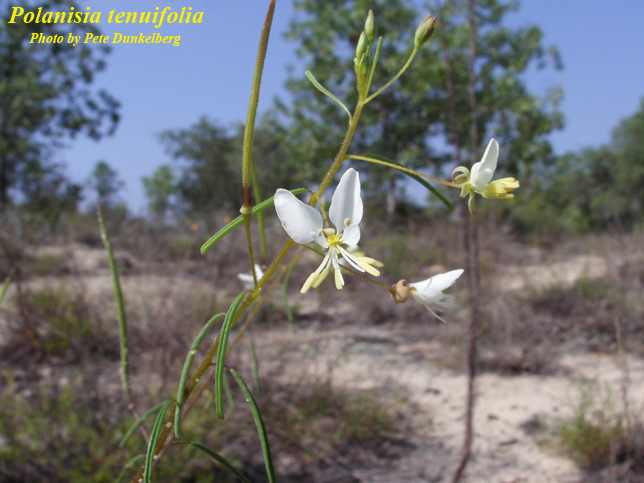Difference between revisions of "Polanisia tenuifolia"
Krobertson (talk | contribs) (→Conservation and management) |
|||
| Line 18: | Line 18: | ||
}} | }} | ||
| − | Common | + | Common names: Slenderleaf clammyweed, Pineland catchfly |
==Taxonomic notes== | ==Taxonomic notes== | ||
Synonym: ''Aldenella tenuifolia'' (Torrey & A. Gray) Greene | Synonym: ''Aldenella tenuifolia'' (Torrey & A. Gray) Greene | ||
| Line 35: | Line 35: | ||
===Seed dispersal=== | ===Seed dispersal=== | ||
This species has vertically dangling pods called siliques, which open gradually dispenses seeds.<ref name="treasure">[[https://treasurecoastnatives.wordpress.com/tag/polanisia-tenuifolia/]]Treasure Coast Natives. Accessed: February 21, 2016</ref> | This species has vertically dangling pods called siliques, which open gradually dispenses seeds.<ref name="treasure">[[https://treasurecoastnatives.wordpress.com/tag/polanisia-tenuifolia/]]Treasure Coast Natives. Accessed: February 21, 2016</ref> | ||
| − | |||
<!--===>Seed bank and germination===--> | <!--===>Seed bank and germination===--> | ||
<!--===Fire ecology===--> <!--Fire tolerance, fire dependence, adaptive fire responses--> | <!--===Fire ecology===--> <!--Fire tolerance, fire dependence, adaptive fire responses--> | ||
| − | |||
===Pollination=== | ===Pollination=== | ||
The following Hymenoptera families and species were observed visiting flowers of ''Polanisia tenuifolia'' at Archbold Biological Station: <ref name="Deyrup 2015">Deyrup, M.A. and N.D. 2015. Database of observations of Hymenoptera visitations to flowers of plants on Archbold Biological Station, Florida, USA.</ref> | The following Hymenoptera families and species were observed visiting flowers of ''Polanisia tenuifolia'' at Archbold Biological Station: <ref name="Deyrup 2015">Deyrup, M.A. and N.D. 2015. Database of observations of Hymenoptera visitations to flowers of plants on Archbold Biological Station, Florida, USA.</ref> | ||
| Line 52: | Line 50: | ||
It produces glandular hairs which are believed to deter insect feeding and creeping.<ref name="treasure"/> | It produces glandular hairs which are believed to deter insect feeding and creeping.<ref name="treasure"/> | ||
<!--===Diseases and parasites===--> | <!--===Diseases and parasites===--> | ||
| − | |||
==Conservation and management== | ==Conservation and management== | ||
Loss of habitat of dunes to vacation homes and resorts is threatening this species.<ref name="eol"/> | Loss of habitat of dunes to vacation homes and resorts is threatening this species.<ref name="eol"/> | ||
| − | |||
==Cultivation and restoration== | ==Cultivation and restoration== | ||
==Photo Gallery== | ==Photo Gallery== | ||
<gallery widths=180px> | <gallery widths=180px> | ||
</gallery> | </gallery> | ||
| − | |||
==References and notes== | ==References and notes== | ||
Revision as of 17:50, 14 September 2016
| Polanisia tenuifolia | |
|---|---|

| |
| Photo by Pete Dunkelberg, Atlas of Florida Vascular Plants | |
| Scientific classification | |
| Kingdom: | Plantae |
| Division: | Magnoliophyta - Flowering plants |
| Class: | Magnoliopsida – Dicotyledons |
| Order: | Brassicales |
| Family: | Cleomaceae |
| Genus: | Polanisia |
| Species: | P. tenuifolia |
| Binomial name | |
| Polanisia tenuifolia Torr. & A. Gray | |

| |
| Natural range of Polanisia tenuifolia from USDA NRCS Plants Database. | |
Common names: Slenderleaf clammyweed, Pineland catchfly
Contents
Taxonomic notes
Synonym: Aldenella tenuifolia (Torrey & A. Gray) Greene
Description
A description of Polanisia tenuifolia is provided in The Flora of North America.
Distribution
It is a regional endemic found in the Florida panhandle to southeast Mississippi.[1]
Ecology
Habitat
Habitats of P. tenuifolia include longleaf pine/scrub oak ridges, sandhills, and dry pinelands. [1] [2] Associated species include Balduina angustifolia, Licania michauxii, Conradina canescens, Opuntia humifusa, O. pusilla, Froelichia floridana, Cypersus retrosus, Stipulicida setacea, Polygonella gracilis, Diodia teres, Triplasis americana,and Heterotheca subaxillaris (UF Herbarium).
Seed dispersal
This species has vertically dangling pods called siliques, which open gradually dispenses seeds.[3]
Pollination
The following Hymenoptera families and species were observed visiting flowers of Polanisia tenuifolia at Archbold Biological Station: [4]
Halictidae: Augochloropsis metallica, Lasioglossum nymphalis
Megachilidae: Dolichostelis louisae, Megachile brevis pseudobrevis
Sphecidae: Cerceris blakei, Ectemnius rufipes ais, Tachysphex similis
Vespidae: Leptochilus krombeini, Microdynerus monolobus, Stenodynerus histrionalis rufustus
Use by animals
It produces glandular hairs which are believed to deter insect feeding and creeping.[3]
Conservation and management
Loss of habitat of dunes to vacation homes and resorts is threatening this species.[1]
Cultivation and restoration
Photo Gallery
References and notes
- ↑ 1.0 1.1 1.2 [[1]]Encyclopedia of Life. Accessed: February 21, 2016
- ↑ Florida State University Robert K. Godfrey Herbarium database. URL: http://herbarium.bio.fsu.edu. Last accessed: October 2015. Collectors: Angus Gholson Jr., Robert K. Godfrey. States and Counties: Florida: Liberty, Putnam. Compiled by Tall Timbers Research Station and Land Conservancy.
- ↑ 3.0 3.1 [[2]]Treasure Coast Natives. Accessed: February 21, 2016
- ↑ Deyrup, M.A. and N.D. 2015. Database of observations of Hymenoptera visitations to flowers of plants on Archbold Biological Station, Florida, USA.